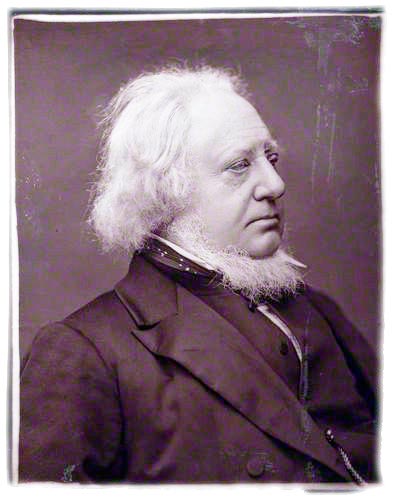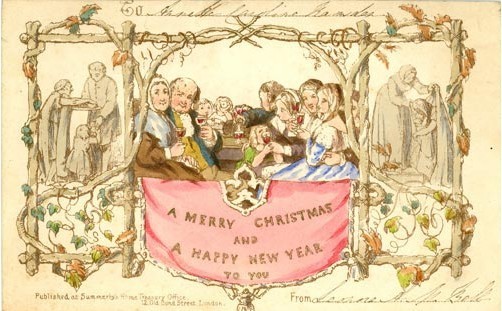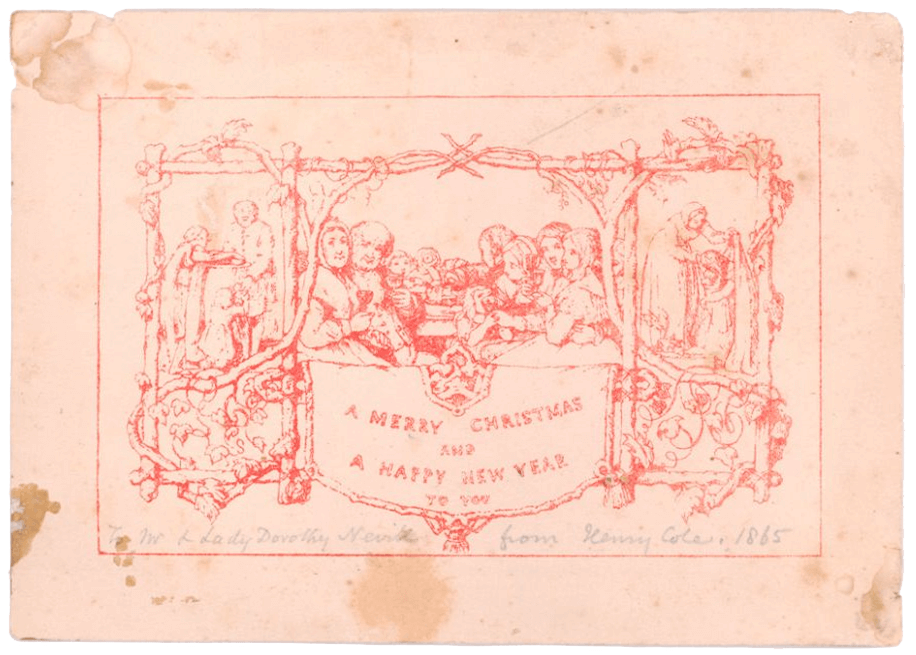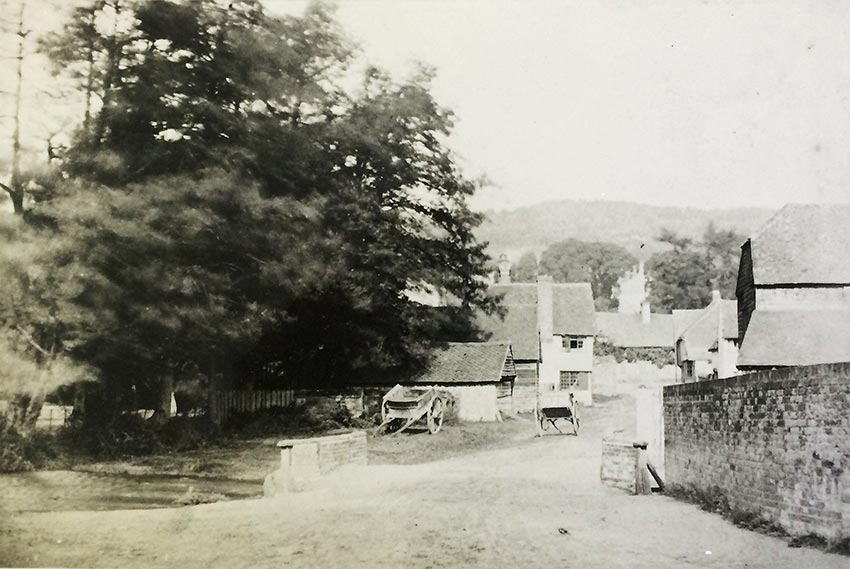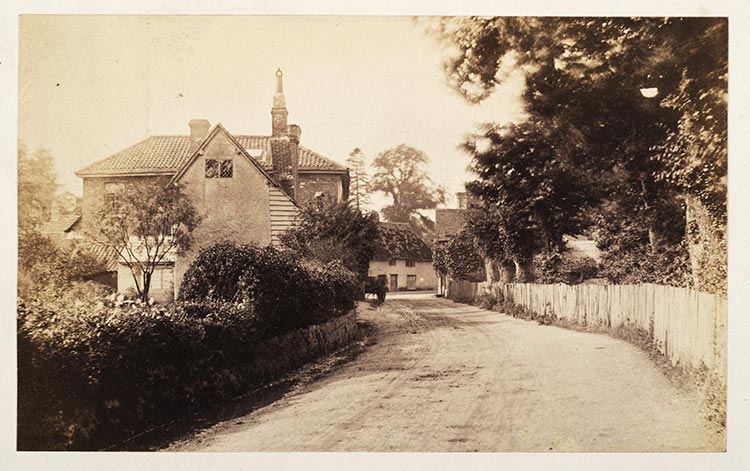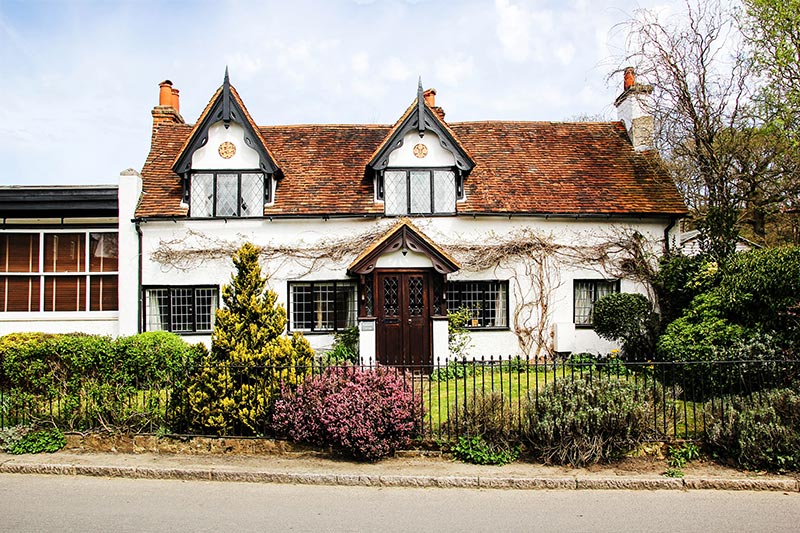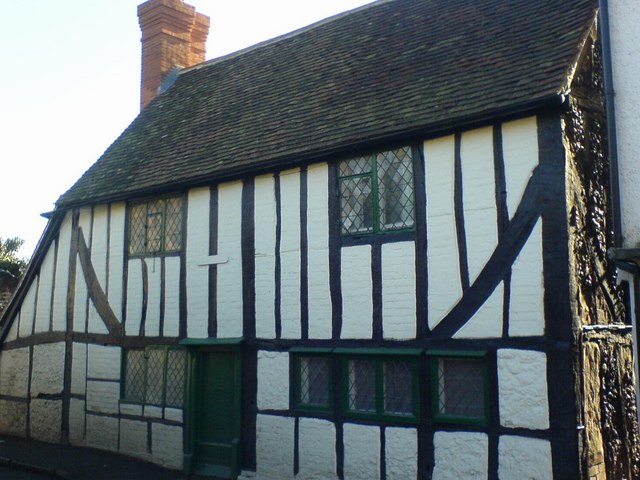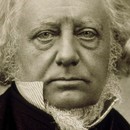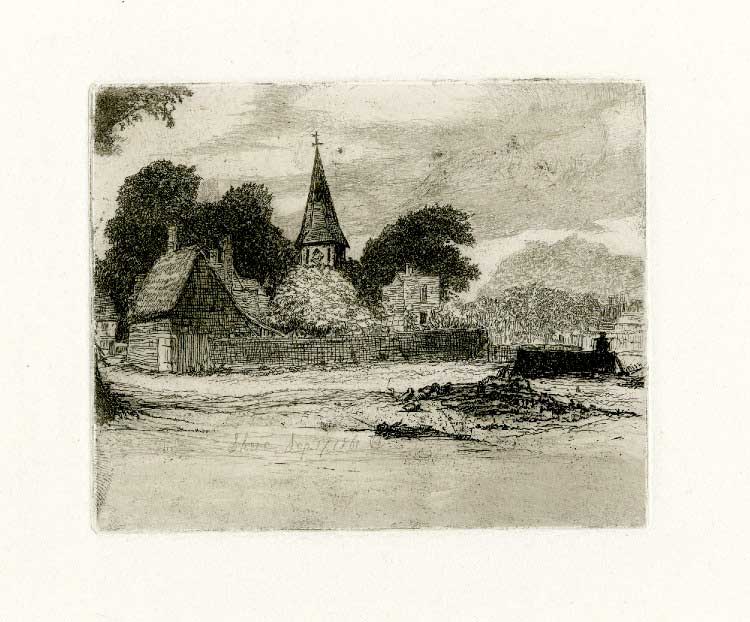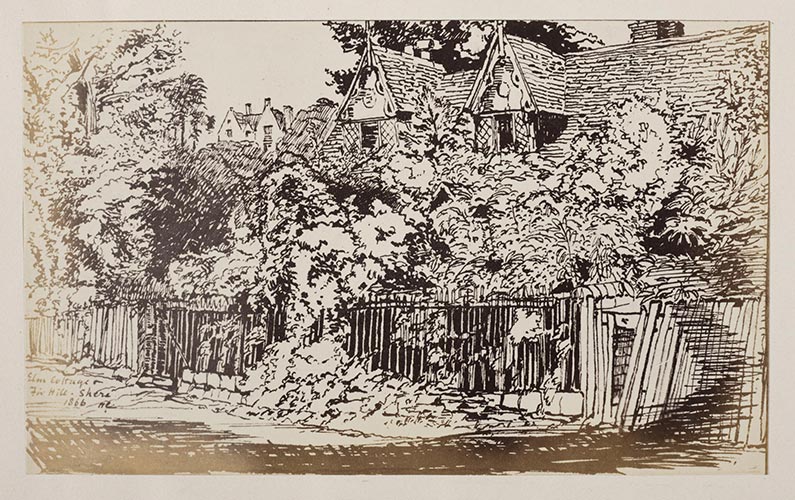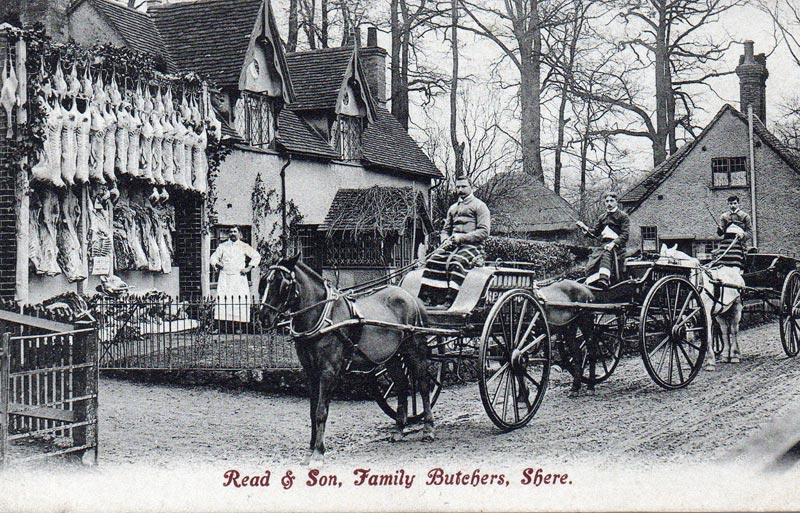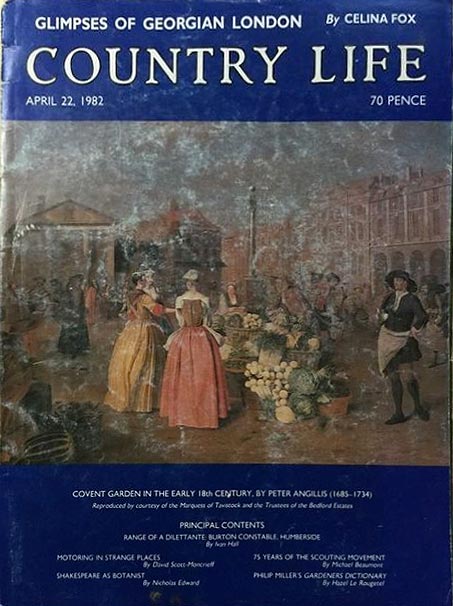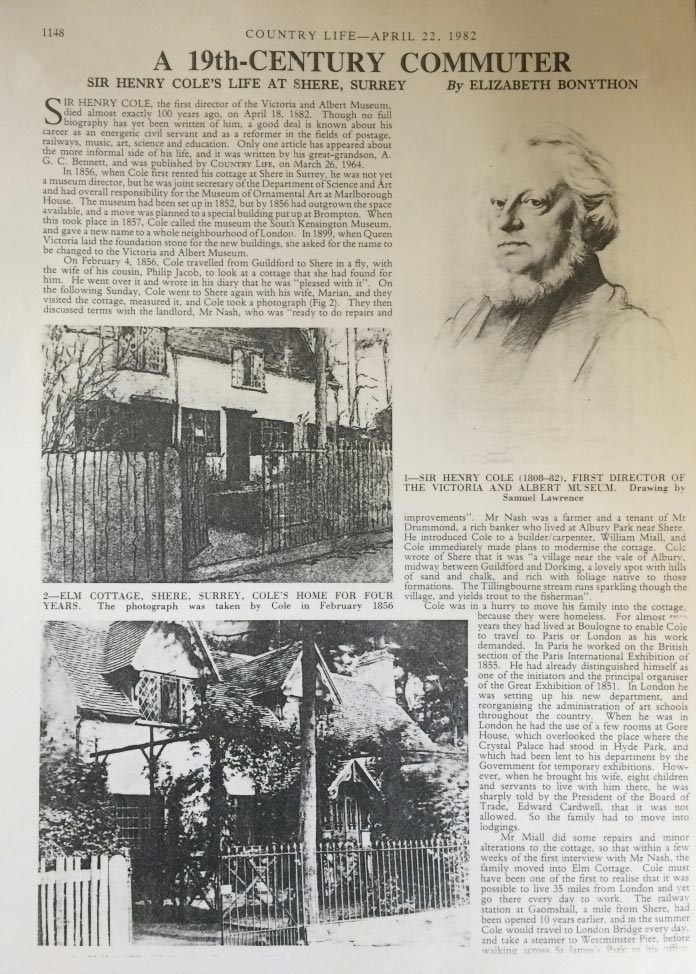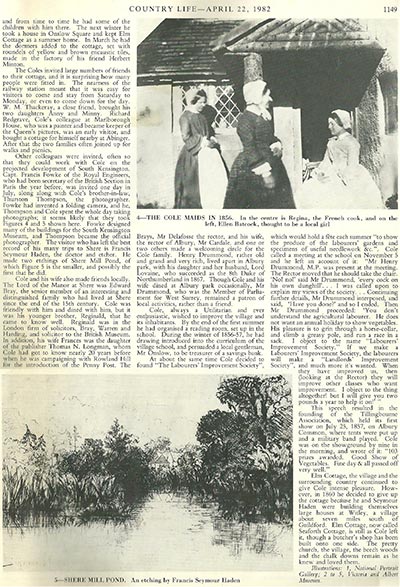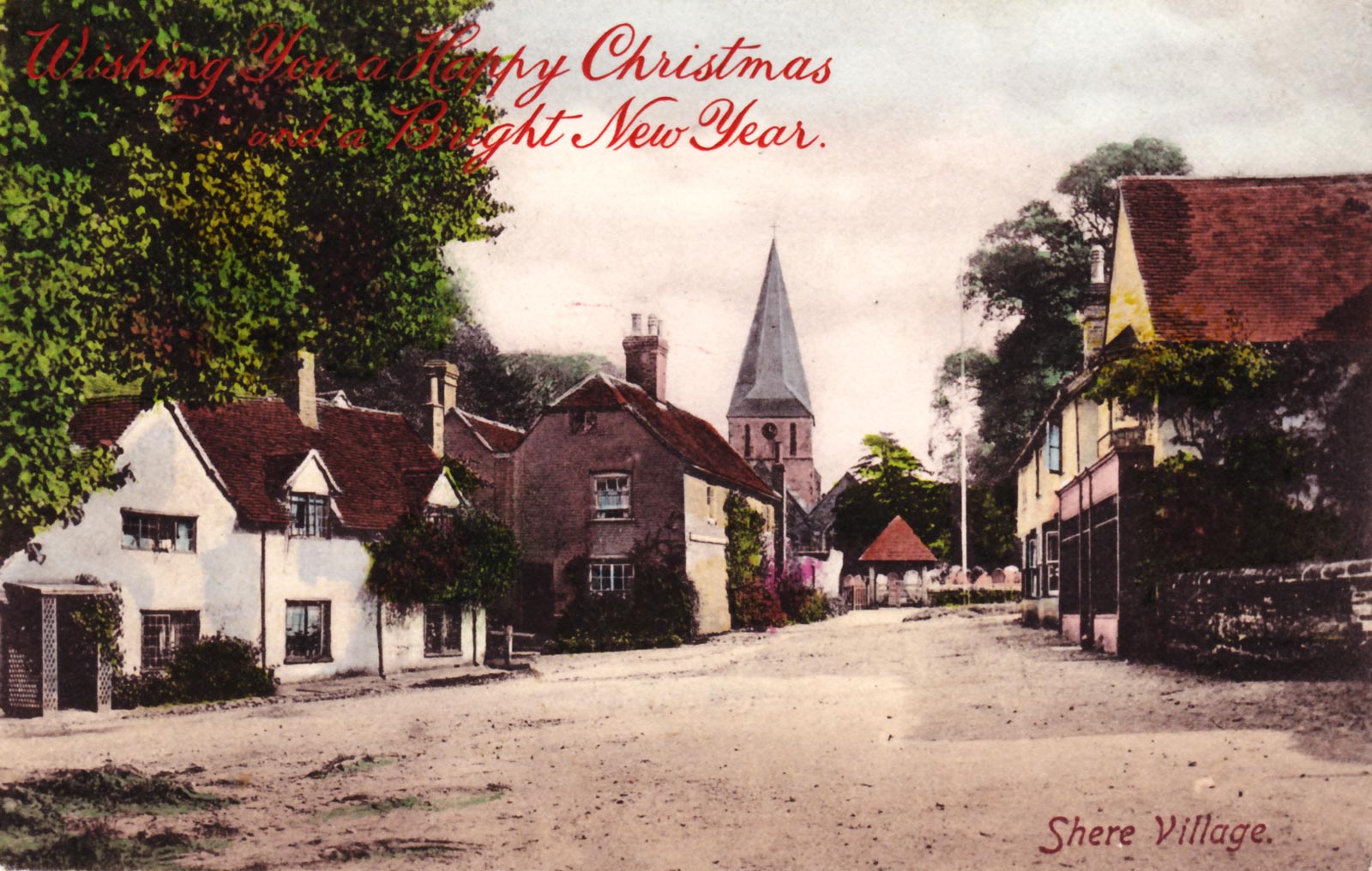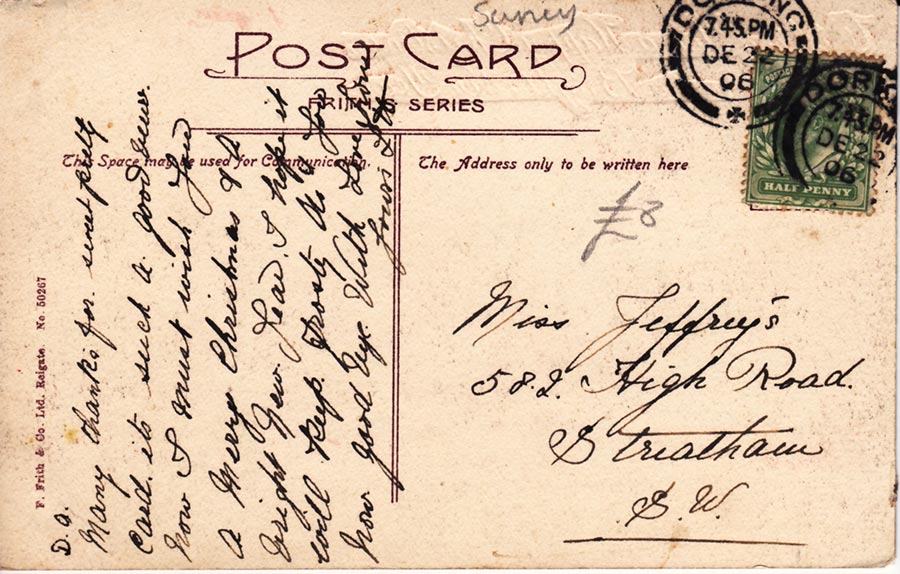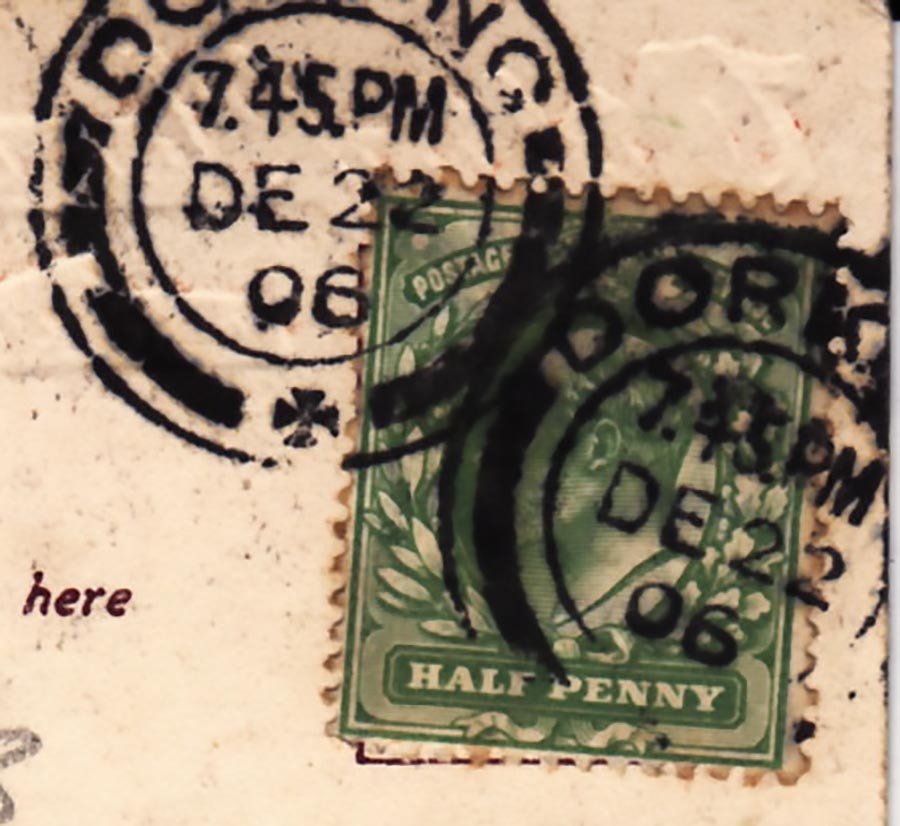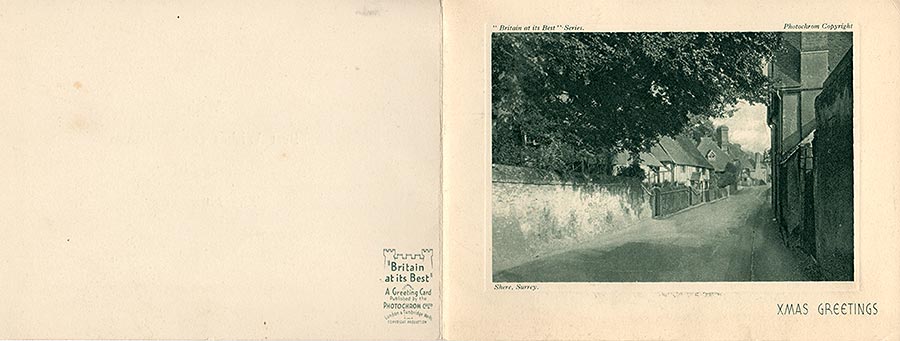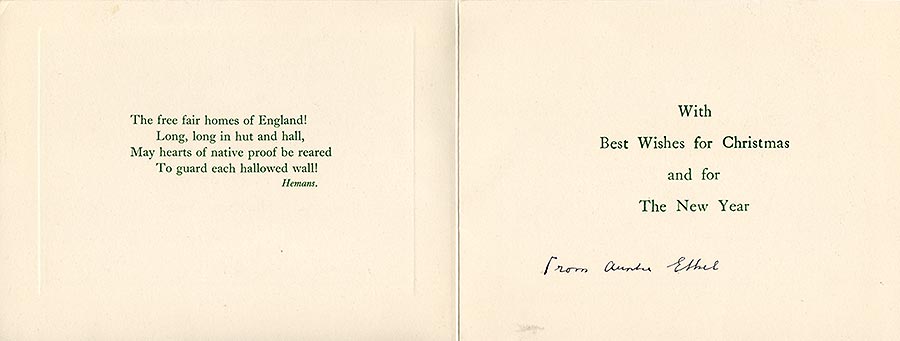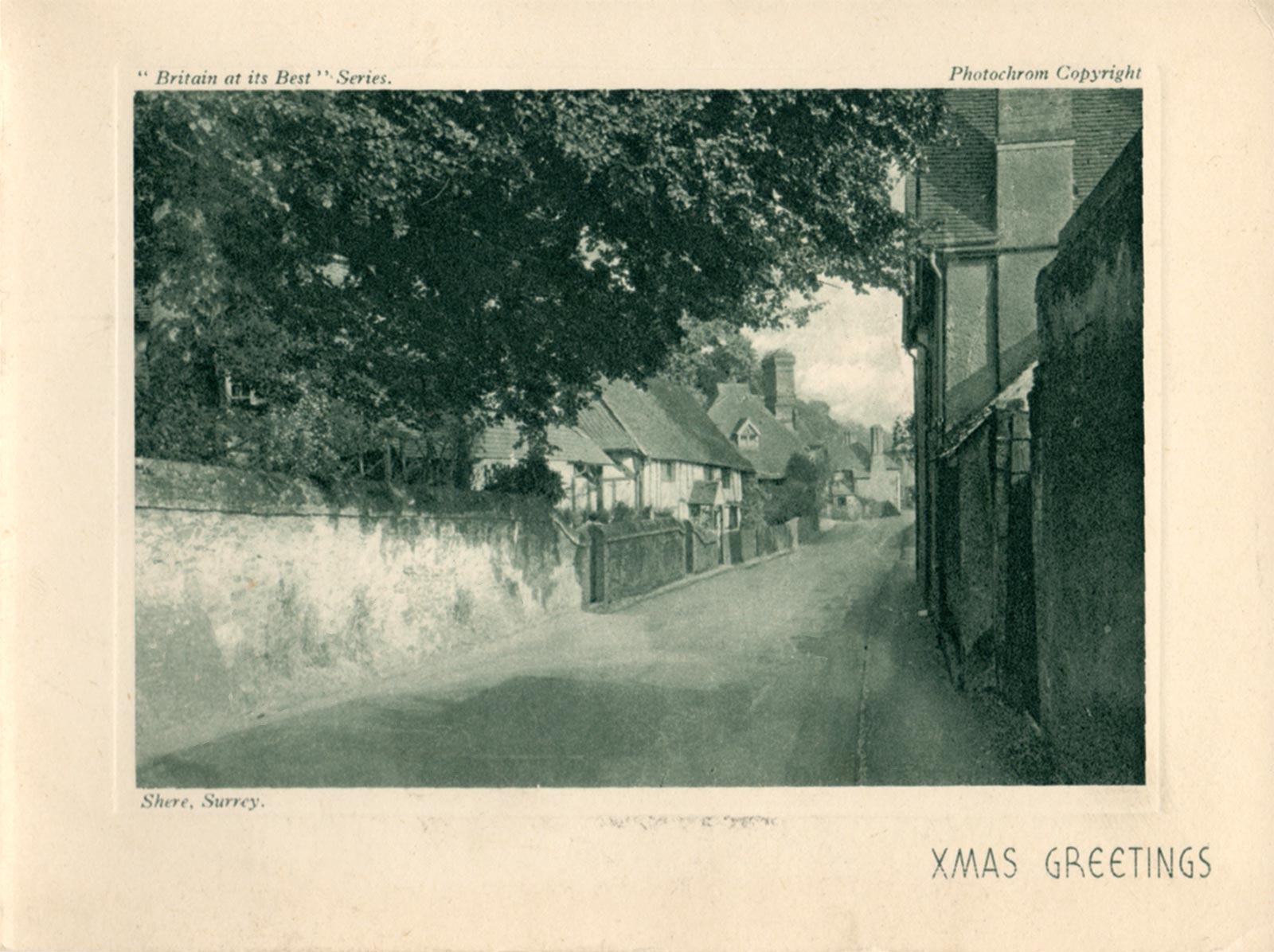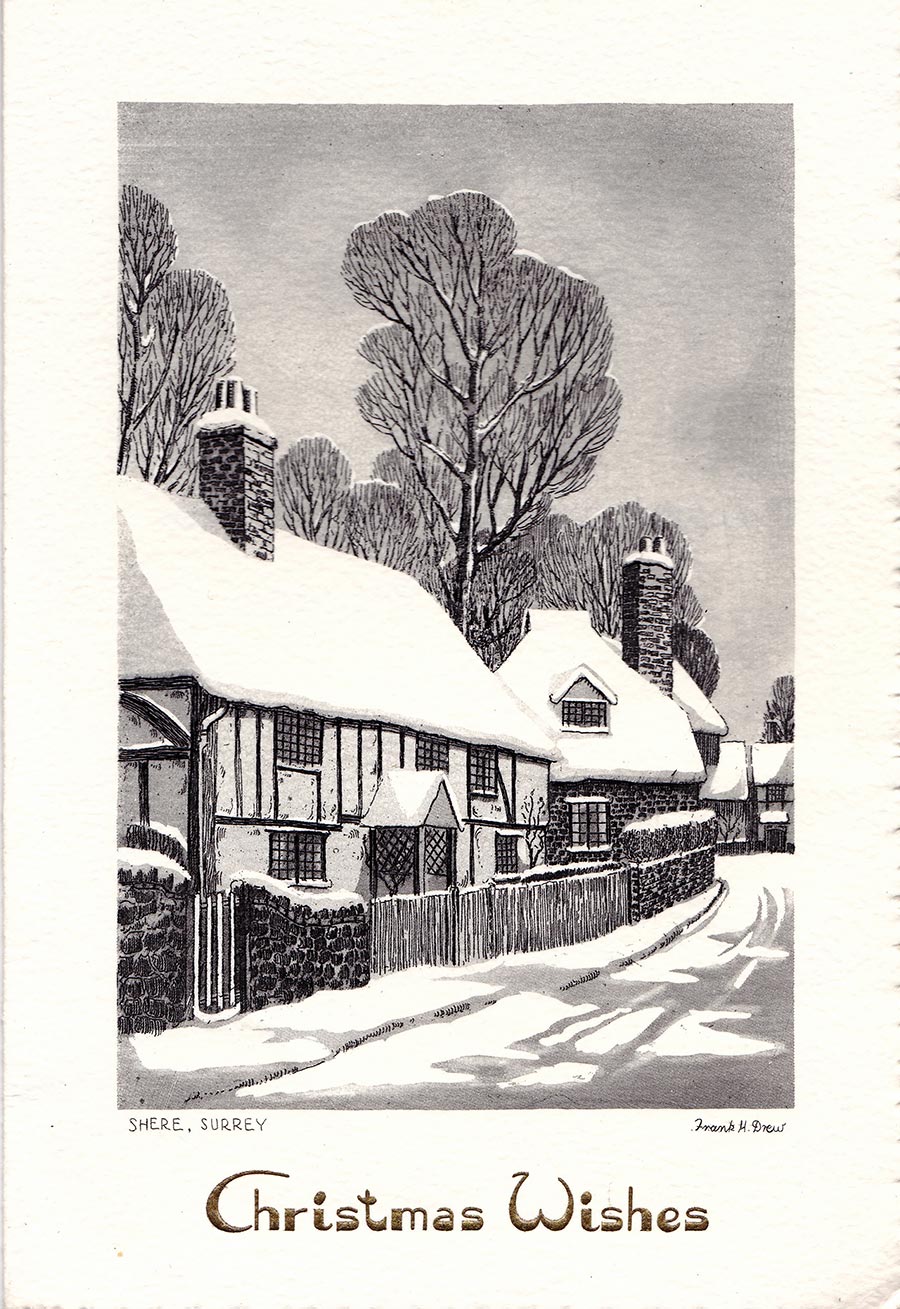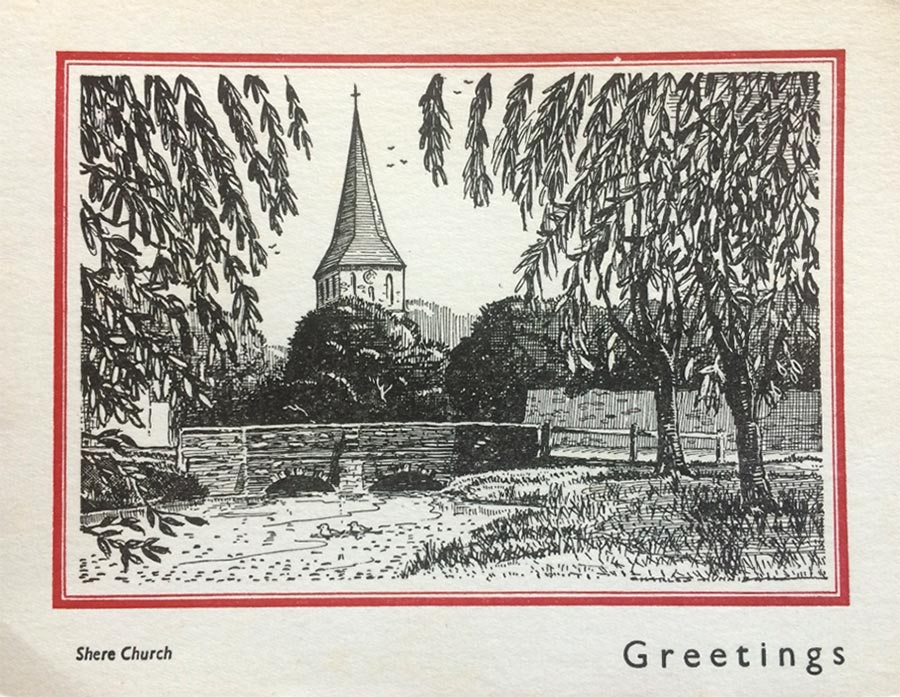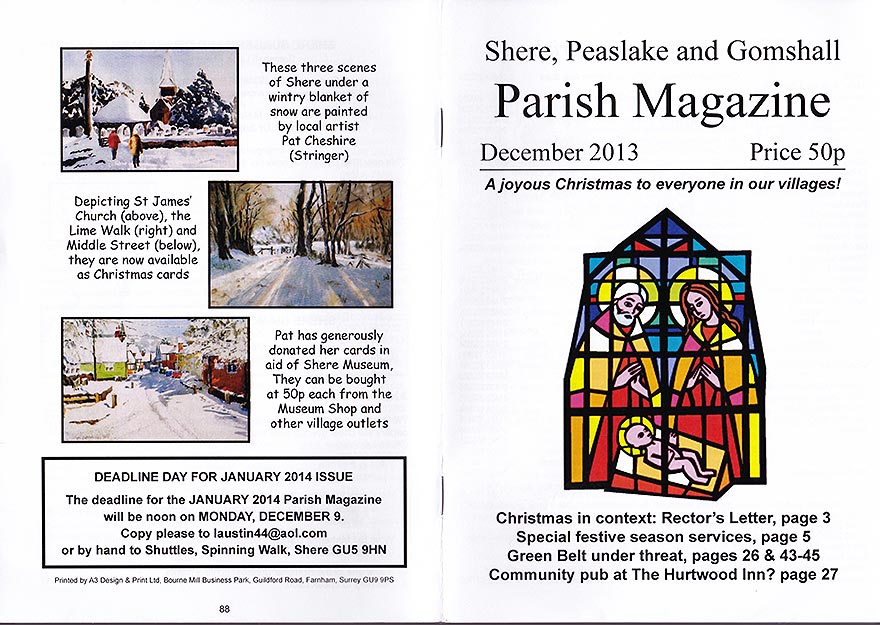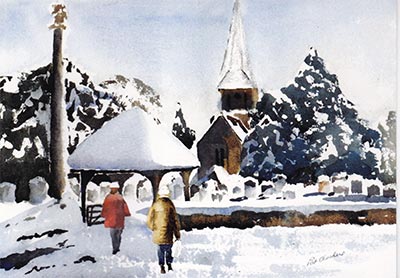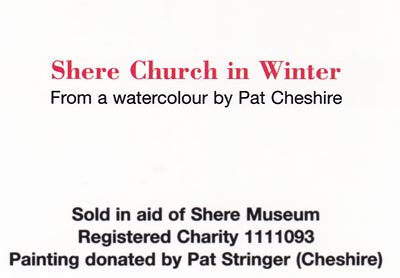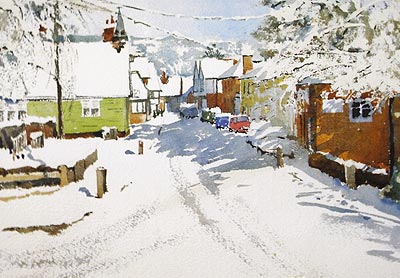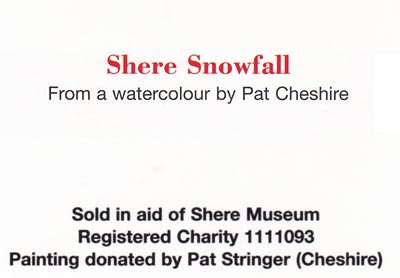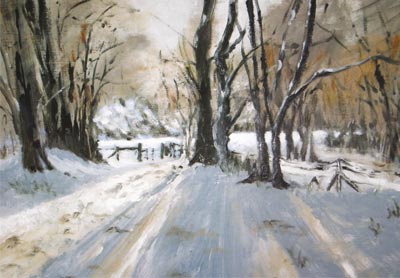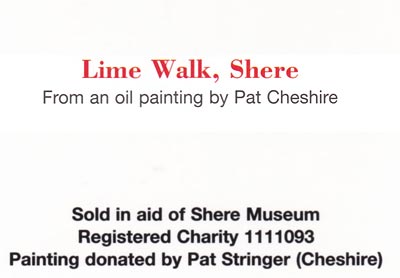Shere is the home of the Christmas Card as in 1843, resident Sir Henry Cole was 'The Man who Invented the Christmas Card'
Sir HENRY COLE (1808 - 1882)Autumn of 1843, an English gentleman named Henry Cole, decided to commission and send printed greeting cards with images that would be marked down in history as the man who invented the Christmas card. In 1840 Cole was credited with being instrumental in revamping the postal system and creating the first self-adhesive postage stamp: the Penny Black. As a member of the Royal Society of the Arts, Cole met Prince Albert and accepted his commission to organize the Great Exhibition of 1851. This merging of art, industry and manufacturing was so successful that there followed similar exhibitions in London and Paris, and it was instrumental in reforming the patent laws a year later.
Sir Henry Cole founded the VICTORIA & ALBERT museum in London.
This is the first commercial Christmas card issued in London, England in 1843, illustrated by John Callcott Horsley. Each card sold for one shilling at the time.
Above: One of 5 Proofs of the First Xmas Card, Inscribed to Lady Dorothy Nevill[Cole, Henry (pseud. “Felix Summerly”)].
A Merry Christmas and a Happy New Year to You. London: [Joseph Cundall for] Summerly's Home Treasury Office, [December 1843]. Price: $12,500.00 - BUY (2016) |
||||||||||||
1850 - Middle Street
Sir Henry Cole was also a keen photographer and the above photo taken in Shere in 1850 is one of the earliest photographs available of the village.
Another Sir Henry Cole photo entering Shere down Gomshall Lane - Note: this was before the Village Hall and Working Mens Club (now Museum) were built on the right hand side. You can see 'Manor Cottage' on the end.
---Sir Henry Cole - His Shere HomeHenry Cole lived at Elm Cottage, Gomshall Lane, Shere during his retirement (shown below): CONFUSED? - This is a picture of 'SEAFORTH COTTAGE' in Gomshall Lane (opposite the School) The previous name of 'Seaforth Cottage' was 'ELM COTTAGE' (Thank you to Marsha Walton), when Sir Henry Cole lived there...
...not to be confused by the present day 'Elm Cottage' in Upper Street, southside, Shere - formerly Gibbles (Grade II listed)
Above: 1856 photo by Henry Cole The following four internal photos were taken on 18th May 1856 at Elm Cottage. These were explained in detail during "The Inaugural Henry Cole Lecture by Sir Christopher Frayling. Viewed HERE (39 minute mark into the lecture) "The inaugural Henry Cole Lecture, held at the Victoria and Albert Museum in London on 30 October 2008. The purpose of the lecture is to celebrate the legacy of the Museum’s founding director, and explore its implications for museums, culture and society today." Partial TRANSCRIPT: "But another more personal example of Henry Cole's own tastes in the 1850s is evidenced by a fascinating series of snaps he took on 18 May 1856 of the drawing room and bedroom at Elm Cottage, his country retreat in Shere, Surrey. These photos were made in the year he purchased the very first example of the art of photography for the Museum's collection; and they were acquired by the V& A as recently as 1987 to add to that collection. There are three photos of the drawing room - some with watercolour retouches by Cole - and one of the bedroom. The contrast between daylight and dark isn't always successful but the glimpse of Cole's domestic arrangements is fascinating - very rare to have photographs of domestic interiors of this kind. The interiors are filled with the clutter of pictures and ornaments - plus Cole's
carefully posed daughters: May(on the left), Tishie (in the middle), and Hennie, seated. This one of the drawing room - you can't really see it - but the framed item on the right is a lithograph of the nave of the Crystal Palace, on the floor, a portrait of Cole in his twenties, and behind them, geometrical, flat wallpaper - which he had selected in London, with Richard Redgrave RA for moral support,on 22 February 1856.
Another of the drawing room has inset fragments of stained glass in the window, and on the table a Parian ware Shakespeare; and one of the rarer products of Felix Summerly's Art Manufactures - the 'Bride's Inkstand' - in the middle. In this one Cole's daughter Mary stands in the bedroom, with its very busy curtains, the wallpaper again, and on the left Shaker-style pegs for hanging things up. Again, not exactly proto-Modernism, although the wallpaper does indeed obey some of the Marlborough House commandments: it doesn't imitate nature, it repeats well, and it takes account of the dimensions of the room. "
READ MORE © Copyright, All rights reserved Research from - Victoria and Albert Museum - The world’s greatest museum of art and design
---
1861 - Middle Street
Shere Church, Surrey - 1861 - View from Middle Street (approx from the position of the, yet to be built, 'Old Fire Station'. - You can see Sayers to the right of St. James' Church and the footbridge over the Tillingbourne river. Illustrator: Unpublished Amateur Etchings | Print made by Sir Henry Cole Image © The Trustees of the British Museum Department: Prints & Drawings Description ---
1866Ink drawing sketch by Henry Cole of his home, Em Cottage (Seaforths) in Gomshall Lane.
---abt. 1900
|
||||||||||||
SIR HENRY COLE (1808 – 1882) Commissioned the First Commercial Christmas CardIn Biography, Holidays, People from England, Traditions on December 20, 2010 at 8:13 PMProfessionally, Henry Cole was a busy and influential man. Maybe that’s why there is a lot more known about his professional life than his private life. With all the demands on his time, he did try to keep up with the social graces, but one year around the holidays, time just got away from him, and he had to solicit help in sending greetings to his friends. Cole started working when he was 15 years old. He was born in Bath, England, the son of an army officer, but he moved to London for the opportunities. One of his first jobs as a civil servant was the Assistant Keeper of Public Records. He fancied himself a writer and began his publishing career with pamphlets about reforming the public record system. His efforts led to the establishment of the General Record Office. Flush with success, Cole, along with two partners, edited and published the Guide newspaper, the Historical Register and the Journal of Design. In addition to writing, design was a field that he was passionate about. It’s unknown whether he was educated in design and the decorative arts or if his passions and instincts fueled his achievements, but his influence spanned administrative duties as well as his own creative projects. A MAN OF MANY TALENTS - Much of Cole’s personal work was done under the name of Felix Summerly. As this alter ego he wrote children’s books, handbooks of the National Gallery, Hampton Court and other art exhibitions, and many articles of various subjects. He also designed the Felix Summerly Tea Service which was made by the Herbert Minton ceramic factory. This became so popular that Cole, perhaps a bit of a snob, opened Felix Summerly’s Art-Manufactures with the goal of commissioning work from artists that would raise the level of industrial design and the overall taste of the general public. In 1840 Cole was credited with being instrumental in revamping the postal system and creating the first self-adhesive postage stamp: the Penny Black. A profile of Queen Victoria was on the stamp, and Cole provided the sketch of her that was used based on a medal done by William Wyon. As a member of the Royal Society of the Arts, Cole met Prince Albert and accepted his commission to organize the Great Exhibition of 1851. This merging of art, industry and manufacturing was so successful that there followed similar exhibitions in London and Paris, and it was instrumental in reforming the patent laws a year later. Cole’s influence extended into education when he was asked, on behalf of the government, to reorganize the Schools of Design. He became head of the Science and Art Department, a job that lasted 21 years. At the end of the Great Exhibition of 1851, Parliament authorized £5,000 to purchase the most striking objects that were on display to be part of a permanent collection along with the best drawings from art schools from around the country. Cole founded The South Kensington Museum to exhibit these works. Queen Victoria was on hand for the official opening, and in 1899 it became the Victoria and Albert Museum. Cole retired in 1873 after 50 years in public service, but that didn’t seem to slow him down. He continued to channel his experience and expertise toward education and established the National Training School for Music and the National Training School for Cookery within two years. In 1875 he was rewarded for his service by receiving the Order of the Bath. It was Queen Victoria herself that recommended he be knighted. STARTING A TRADITION With all of this resume building, it’s easy to imagine that in 1843 Cole was just too busy to write Christmas cards. The custom at the time was to hand write each one individually, but that just wasn’t going to happen. Cole hired London artist John Calcott Horsley to design a card for him to send to all his friends. It was a triptych with scenes on each of the side panels depicting the charitable essence of Christmas: feeding the poor and clothing the homeless. In the center was the message “Merry Christmas and Happy New Year To You” under a colorful drawing of a family celebrating, their wine glasses raised in a toast. Horsley made 1,000 lithographic copies of his greeting card measuring 5 1/8 inches by 3 and 1/4 inches, and he hand colored each one himself. The cards that Cole did not send were sold in the Felix Summerly art shop on Bond Street in London for six cents each. Since it is estimated that there are only about a dozen still in existence, they have become quite collectible. In December 2008 one sold for £8,500 (over $13,000 today). Cole never slowed down even as he aged. He had a known heart condition, but at the end of 1881, with the help of his daughter, he started writing his memoir highlighting his half century of public service. On Monday, April 17, 1882 Cole sat for a portrait with the famous painter Whistler. That night his condition worsened, and he died the following evening. ©2010 Debbie Foulkes all Rights Reserved - WEBPAGE |
||||||||||||
Various examples of Christmas cards centered around Shere
|
||||||||||||
1906 - Wishing You a Happy Christmas and a Bright New Year
|
||||||||||||
Upper Street
Best of Britain Series - Christmas Card
Best of Britain Series
Best of Britain Series - Front Detail |
||||||||||||
A beautiful example of a 'Snowy Shere' Christmas card.
If anyone has any more examples of Christmas cards featuring Shere, I would love to view them and maybe we could share these on this page. e-mail me here - Many thanks, Tristan |
||||||||||||
Recent Christmas Cards2013
On the back of this months Parish Magazine - there are three beautiful winter scenes of Shere by local artist Pat Cheshire (Stringer).
Christmas cards are in aid of the Shere Museum and can be purchased for 50p each from the Museum Shop and other village outlets. |
 |
 |
